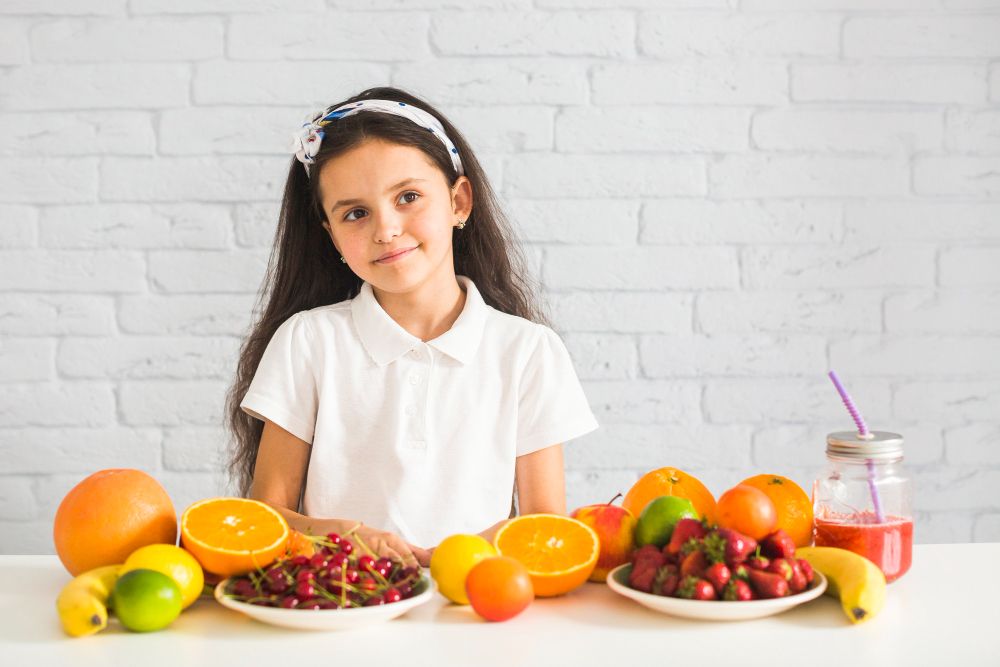Proper nutrition in children is essential for growth, development, and maintaining good health. Parents and caregivers basically hold knowledge on the nutritional needs of their children to enable them to make wise decisions towards their diets. This therefore gives this blog an overview of the primary nutritional requirements, reasons for a balanced diet, and gives practical examples of healthy food options for kids. We will also look at some of the key questions associated with this: What is the need for nutrition for children in order to grow, how many calories they need each day based upon their age, and what type of diet is recommended for different age groups.
What Nutrients Are Essential for Children's Growth and Development?
Children have high nutrient needs to support their rapid growth and development. These nutrients can be categorized into macronutrients and micronutrients. A healthy diet should provide not only adequate amounts of nutrients but also a proper balance between specific classes of nutrients. Both macronutrients and micronutrients play critical roles in sustaining health and achieving optimal physical and cognitive development.
Macronutrients
Carbohydrates: The major energy sources for children are carbohydrates. They support physical activity and act as fuel for the brain. The source of complex carbohydrates should be from unrefined sources, since they provide sustained energy and are also, importantly, sources of vitamins and minerals.
Proteins: They are important in growth, repairing tissues, and in building up the immune system. They are therefore the building blocks of the body, under development of muscle, and for making enzymes. Daily needs of protein vary by age but are typically around 13-34 grams per day for children aged 1 to 13 years.
Fats: Healthy fats support the growth of the brain, production of hormones, and absorption of fat-soluble vitamins A, D, E, and K. Avocado, nuts, seeds, and fish are a few sources of healthy fats. Limit saturated and trans fats, mostly from fried foods and processed snacks.
Micronutrients
Vitamins:
-
Vitamin A: Crucial for vision, immune function, and skin health. Food sources include carrots, sweet potatoes, dark leafy green vegetables.
-
Vitamin C: The primary functions of Vitamin C are for immune support, skin health, and iron absorption. Excellent sources are citrus fruits, strawberries, and red bell peppers.
-
Vitamin D: Needed for the health of bones and calcium absorption. A natural source includes sun exposure; enriched dairy produce, fatty fish.

Minerals:
-
Calcium: Building and developing bone and teeth. Milk, green leafy vegetables, fortified plant-based milk.
-
Iron: Required for making red blood cells to transport oxygen. Food sources include lean meats, beans, and cereals that are fortified.
-
Zinc: Needed for immune system function and the growth of cells. Food sources include meat, shellfish, legumes, nuts.
How Many Calories Do Kids Need Per Day Based on Age?
Caloric needs of children vary with age group, sex, activity level, and rate of growth. A general guide to daily intake would be as follows:
-
Toddlers (1-3 years): 1,000-1,400 calories
-
Preschoolers: 1,200-1,600 (4-5 years)
-
School-age: 1,400-2,000; 6-12 years
-
Teenagers: 1,800-2,400 for girls, 2,200-3,200 for boys
These are approximate values and vary from person to person. For instance, an active child would require a greater amount of food intake in order to be able to spend that amount of energy.
What Are Examples of Healthy Food Choices for Kids?
A good mix of the following healthy foods will allow for adequate nutrition in a child. Following are examples of some healthful choices at various ages:
Healthy Diets for Preschoolers
-
Breakfast: Whole grain cereal topped with milk and serving fruits
-
Snacking: Transversely cut cucumbers, hummus
-
Lunch: Sandwiches of whole-grain bread with turkey and cheese. Side dishes of carrot sticks and apple slices.
-
Snacking: Yogurt sprinkled with granola.
-
Dinner: Grilled chicken, quinoa, steamed broccoli, with a side of strawberries.
Wholesome Diets for School-Age Children
-
Breakfast: Oatmeal with berries and a glass of milk.
-
Snack: A handful of nuts and a piece of fruit.
-
Lunch: Bean and cheese quesadilla with cherry tomatoes and a banana.
-
Snack: Veggie sticks with guacamole.
-
Dinner: Baked salmon, brown rice, green beans, and a peach.
Wholesome Diets for 12-Year-Olds
-
Breakfast: Smoothie with spinach, banana, Greek yogurt, and a splash of orange juice
-
Snack: Cheese on whole grain crackers
-
Lunch: Chicken salad with mixed greens, cherry tomatoes, cucumbers, with a whole-grain roll on the side.
-
Snack: Apple slices with peanut butter.
-
Dinner: Spaghetti marinara sauce, lean ground beef, side salad, and an orange.
Special Considerations and Tips for Parents End :
Variety and Balance: Include a variety of foods in the diet to ensure a balanced intake of all the food groups. This provides a wide range of nutrients necessary for proper growth and development.
Hydration: Encourage children to drink at least eight to ten glasses of water throughout the day. Limit sugary drinks and opt for water or milk as primary beverages.
Portion Control: Set a comfortable pace and be mindful of portions to help prevent overeating. Help children tune in to feelings of satisfaction so they know when to stop eating when they are content, as opposed to stuffed.
Healthy Snacking: Offer healthy snacks between meals that will keep their energy levels steady. Fresh fruits, vegetables, nuts, and, of course, yogurt make great choices for snacks.
Involve Children in Meal Planning: Engage your children in meal planning and its preparation to create interest in healthy eating. This is also a way of teaching them about nutrition and preparing balanced food.
Set a Good Example: Children often mimic the eating habits of their parents. By modeling healthy eating behaviors, parents can influence their children's dietary habits positively.
Parents must understand the need for nutrition which plays a critical role in fostering their children's long-term well-being and success.
Addressing Common Dietary Concerns

Protein Daily Requirement
An adequate supply of protein in the diet ensures the growth and development of children. High-quality protein sources are lean meat, poultry, fish, eggs, milk, beans, nuts, and seeds. Vegetarians can ensure their intake of proteins by combining different types of plant-based dietary sources such as beans and Rice.
Preschooler Diet
Preschoolers have special needs, as times of growth and development are very rapid. Offer a variety of foods in appropriate portions, introduce new foods one at a time, in small portions, and at pleasant mealtimes. Recommend a variety of fruits, vegetables, whole grain products, lean protein sources, and low-fat dairy products.
Some children may have certain, special dietary requirements or restrictions because of allergy, intolerance, or medical condition. Such a need should be respected by tailoring the diet appropriately while making sure a child receives all the necessary nutrients. This will help provide personalized guidance consulting with a pediatrician or registered dietitian.
Healthy Diets for 12-Year-Olds
At this age, they become more active, so they may need more intake of calories and energy. Encourage them to eat well-balanced diets with proteins, whole grains, fruits, and vegetables. Show them how to go for good nutrition and make proper food choices on their own.
Young People's Eating Habits
The need for nutrition in children is paramount for their growth and cognitive development. Proper nutrition ensures they receive essential vitamins and minerals that support strong bones, a robust immune system, and overall health.
Children and teenagers consumed fewer sugar-sweetened beverages between 2001 and 2010, however they still make up 10% of total calorie intake.
The amount of whole fruit and total fruit consumed by children and adolescents increased between 2003 and 2010. Still, the majority of young people do not consume enough fruits and vegetables.
For kids and teenagers (2–18 years old), 40% of daily calories come from added sugars and solid fats, which are empty calories that degrade the quality of their meals as a whole. Six foods and beverages account for around half of these empty calories: pizza, whole milk, fruit drinks, dairy desserts, and soda. Most young people don't drink as much water as is advised in total.
Conclusion
Providing our children with the nutrition they need is one of the basic responsibilities that builds the concerns of their future health and well-being. Ensuring a balanced intake full of essential foods that render important nutrients isn't another chore for kids; it's a promise to their growth, development, and happiness. Understanding the need for nutrition helps parents provide meals that support their children's overall health and future well-being.
This is a complete guide to help you understand basic nutrition for children, which will highlight some critical issues parents and caretakers need to take into consideration in the process of raising healthy and thriving children.
FAQS :
What are the nutritional needs of children?
3 to 5 ounces of Protine
1 to 1.5 cups of Fruits
1.5 to 2.5 cups of Vegetables
4 to 6 ounces of Grains
What is a balanced child’s diet?
Healthy eating through childhood lowers the chance of your child developing health problems as they get older. Eating healthily means eating a variety from all 5 food groups: fruit, vegetables, grains, protein, and dairy. Foods high in sugar, saturated fat, and salt aren't necessary for a healthy diet; therefore, limit them.
What are the nutritional foods for kids?
The Top 10 Healthiest Foods for Kids
-
Yogurt.
-
Beans.
-
Eggs.
-
Avocado.
-
Sweet Potato.
-
Milk.
-
Nuts and Seeds.
-
Whole Grains.
-
Berries
-
Vegetables.Any kind.
What are the nutritional needs of a child in the age group of 5-10?
They should be given liberal amounts of high-energy foods, high in carbohydrates—whole-grain cereals, full-fat dairy or soy milk, vegetable oils, fruits—two servings—and boiled, baked, steamed, or sautéed vegetables—three servings. A little butter is also helpful in adding energy for their needs.
Do Children Need Vitamins Or Supplements?
Typically, a healthy and balanced diet can provide children with all the necessary nutrients they require. According to the USDA, children should get one to two cups of fruit and one to three cups of vegetables each day, which should cover their vitamin needs. However, in certain instances, a healthcare professional may suggest supplements or vitamins to fulfill your child’s nutritional requirements.
What Are Common Food Allergies In Children
It is estimated that 32 million Americans have food allergies. This includes 5.6 million children under the age of 18. With this type of prevalence, it is important to be aware of some of the most common food allergies in children. Eggs, milk, peanuts, wheat, soy, peanuts, and tree nuts are among some of the most common food allergies. In most circumstances, your child’s nutrition will not suffer if they are allergic to one of these foods.
Liked what you read? Feel free to share this article with your friends and spread the knowledge!
Related Blogs
Supporting children's health: how schools and local groups ensure your child’s well-being.
Mental Health and Well-being for Kids: Find effective ways to support children's mental health and well-being.
Common Nutritional Concerns for Kids: Find common nutritional issues in kids and get tips



Speak Your Mind
Save my name, email and website in this browser for next time I comment